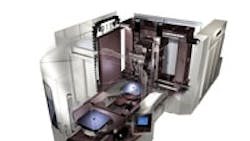Compelling evidence of titanium's emergence as a performance material was implicit in the planning of Cincinnati Machine's booth at this month's IMTS 2006 show. The machine tool company surmised that titanium, not aluminum, will be used with the composite structure of aerospace manufacturer Boeing's 787 Dreamliner. And Cincinnati Machine also heard predictions that global titanium machining capacity was inadequate for aerospace needs. Unprecedented growth is expected.
Cincinnati Machine's easy decision was to concentrate on showing machining solutions for the tough, slow-to-machine material. That's why it wants to give booth visitors an opportunity to consult with metal cutting experts demonstrating what titanium machining requires. The equipment: the company's new MEGA5 5-axis Horizontal Machining Center, a configuration optimized for the machining of titanium.
| See Also... |
Enhancements to the MEGA5 include a patented damping technology to change the machine's natural frequency and virtually eliminate chatter; a new coolant and coolant delivery system optimized for titanium machining; new tooling that delivers extended life in cutting titanium; and an improved method of chip evacuation and removal. Cincinnati Machine says the result is a nearly 100% improvement in throughput for the optimized machine compared to a conventional process for the same part.
